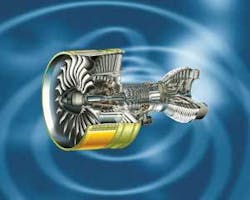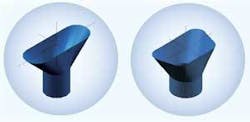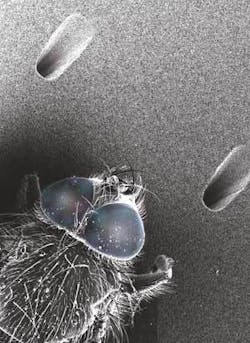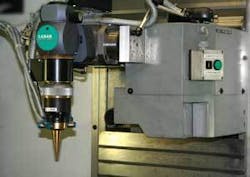3D drilling, a combination of laser drilling and laser erosion, enhances turbine efficiency
Franz-Joseph Gruber
Using laser beams to machine cooling holes in turbine blades is not new; this process has been standard practice at engine-manufacturer MTU Aero Engines in Munich, Germany, for years. Neither is 3D drilling new, as MTU has been using high-tech erosion technologies for quite some time. Yet 3D drilling with lasers is a less well-known machining method for these applications.
The implementation of this production technology at MTU is a success story, with the keywords being production, efficiency, and verifiable profits for users of the end product. Dr. Ing. Mark Geisel and his team in the turbine-blade-production technology division at MTU have been the innovators in the use of the technology.
The first prototype was manufactured three years ago. Since then the process at the MTU production facilities has evolved into a highly efficient standard procedure. All new turbines are fitted with blades machined by this technology, and older models are being optimized and redesigned accordingly (see photo).
Demand for 3D holes
Why is there a demand for 3D holes? After all, cylindrical holes, typically machined by lasers for nearly 20 years, have always fulfilled their cooling purposes with good results. The answer lies in the greater cooling efficiency of the 3D holes.
Geisel explains: “The temperatures under which these turbine blades operate come very close to the melting point-normal steel would be destroyed after a few minutes. Therefore, we use monocrystalline materials, which are, perhaps, the most demanding materials currently used in machine building. We direct all our efforts toward maximizing turbine-engine efficiency. Heat physicists have calculated that integrating a diffuser, that is, flaring the bore inlet, helps to increase cooling efficiency-essentially because the cooling air distributes itself like a uniform film over the blade” (see Figure 1).
This increases the turbine’s overall efficiency by about one percent, which doesn’t sound like much at first. However, this one percent represents a temperature difference of about 100°C. The real advantage of the enhanced cooling capacity is the higher overall efficiency. According to reports, one-quarter of an airliner’s total costs are attributed to fuel, and increasing a turbine’s overall efficiency by just one percent is a remarkable improvement.
But this was known even before the introduction of 3D laser drilling. Lasers already had been used for erosion on certain engines. However, the exorbitant tool costs were a problem for the production specialists, and at the administrative level every possible machining strategy was considered. The result was that laser applications (at least on paper) turned out to be the winner in all categories.
The theoretical efficiency of laser machining practically demanded implementation in the field. Geisel says, “In 2000, we brought several partners on-board for a research project to pursue this subject further.” The Optics Department at Friedrich Alexander University in Erlangen, the Daimler Chrysler research division in Ulm, and industrial partner Sauer Lasertec (or Lasertec Pfronten GmbH) pooled their resources for this project, sponsored by the Bavarian Research Foundation. The tasks included drawing up specifications for lasers and components and organizing genuine, fixed-cycle series production.
The procedure was qualified on the basis of a component now used in the A380. Following the presentation of the prototype 3D laser drill in November 2003, series production of this component began without transition and without problems. So the first chapter of this success story was written-a story that has continued with six systems installed to date. Says Geisel: “We have clearly exceeded the economic profits we calculated earlier.”
There are now six Lasertec 80 Powerdrill units operating in Munich, over three shifts, for 3D laser drilling. These are robust and highly dynamic five-axis machines, fitted with linear drives along the x and y axes and torque motors in the swivelling and rotary axes. They differ from a conventional laser drill in that they feature two integrated laser sources, one for drilling and the other for erosion.
MTU uses the drilling laser from Lasag (www.lasag.com) and the Q-switched erosion laser from Rofin-Baasel (www.rofin.com). Geisel says, “Nevertheless we are still by ourselves on a wide terrain. It is also clear to competition that the production costs with conventional machining will be too high over the long run. At some time or another, somebody else is certainly going to aim for the same goal.”
Taking a closer look
In operation, the laser drills the basic cylindrical hole. Then the part moves underneath the erosion laser to “laser out” the funnel-shaped cavity. Says Geisel, “The technology of laser erosion is well known in the cutting-tool industry, which means it certainly isn’t new.”
But there are substantial differences. In tooling, bigger geometries are lasered out. As for blades-complex, 3D components-there are hundreds of shaped holes to generate-up to 400-and every one of them individually (see Figure 2). That means the biggest challenge is the exact positioning of the blades underneath the laser beam. It becomes more difficult when one considers that even such precise raw castings have inherent tolerance deviations, resulting in further problems vis-à-vis the laser’s beam focus. With the right sensor technology this can be controlled.
The greatest challenge of all for process control, though, is how to implement series production. Geisel remarks, “We are required to work quickly and to recoup our investments with productivity. We have given much thought to process control and implemented a lot of technical tricks in the machine. If our erosion method was to compete with a tool builder without this technology I think we would be considerably faster.”
Owing to each turbine blade’s individuality, it is impossible to pin down how much time is needed to laser machine a blade. Yet, with these six machines in operation in Munich it is fixed-cycle, three-shift series production. Geisel says, “The process is highly complex and must be mastered. There are a great many facts coming together that must be understood, for example, that more than one zero point must be taken into consideration for each workpiece and sensor. Without qualified personnel it won’t work, and that’s something you have to know, as well.” But this ultimately holds true for all sophisticated production methods and all the more so in the world of aerospace.
Another question relates to what the most precise method is. Geisel’s answer is: “Yes, erosion can be better. Even today we have applications that require it. In this case, though, the selection criterion is not precision, but the aspect ratio. We cannot seriously consider using lasers for some aspect ratios. Laser erosion, on the other hand, exhibits accuracy that is good down to a few microns, and that’s perfectly adequate. We work with precision on the scale of 10 µm with fast fixed cycles corresponding to genuine series production. Under these series conditions it is far superior to any other method, even where production quality is concerned.”
Geisel dispels all doubts as to whether the combination of laser drilling and laser erosion, that is, 3D laser drilling, should now be regarded as a standard method, even though for some time to come erosion will continue to uphold its right to exist for only a handful of special applications, even at MTU. All things considered, he and his team have provided the perfect example of a successful laser application that combines refined engineering with not only the customer’s economic profits, but also with drastic cuts in production costs.
Franz Gruber, editor of EuroLaser, has generously shared this article, which appeared previously in his magazine.
MACHINING HOLES
Using Laserform drilling, Mill-Aero Engines has installed an efficient process for machining shaped holes. The laser creates flared holes in rotor and guide blades of high-pressure turbines. The advantage is an improved airflow over the component’s surface. The corresponding increase in cooling allows for turbine inlet temperatures and thus improves its efficiency. The machines operate within a two-stage process: first, the laser drills a cylindrical hole with a diameter of 0.25 to 0.85 mm. After that, a second laser creates the funnel-shaped part of the hole. The MTU-Aero Engine plant in Munich/Bavaria is home to six laser systems-reportedly the only one of its kind in the world.
MTU AERO ENGINES
MTU Aero Engines is one of Germany’s leading engine manufacturers. From its central headquarters in Munich with about 4700 employees, MTU runs its subsidiaries and organizes a major part of its R&D activities. The company develops, manufactures, and supervises civil and military aircraft engines and stationary industrial gas turbines. The company employs about 6700 workers and is represented by subsidiaries in all key markets and regions. In 2005 it achieved a turnover of €2.15 billion. In the next few years the company intends to concentrate on its core business, participate in new engine programs, and expand its service portfolio.
MTU products represent key components and subsystems in all thrust and performance categories. The company collaborates with other manufacturers on new drive systems.



